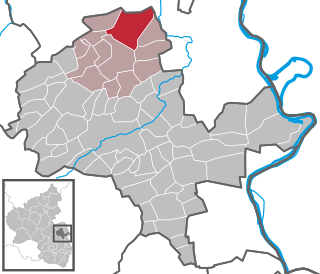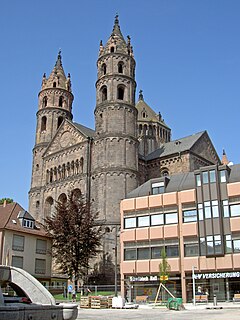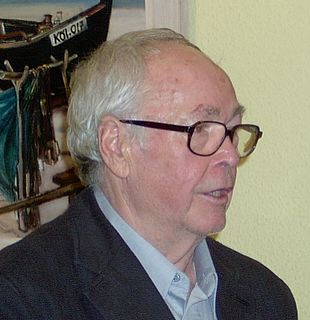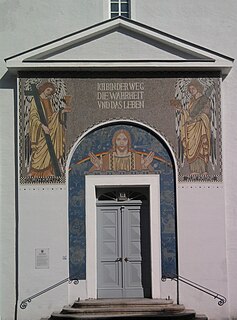
The Diocese of Mainz, historically known in English by its French name of Mayence is a Latin rite of the Catholic church in Germany. It was founded in 304, promoted in 780 to Metropolitan Archbishopric of Mainz and demoted back in 1802 to bishopric. The diocese is suffragan diocese in the ecclesiastical province of the Metropolitan Archdiocese of Freiburg. Its district is located in the states of Rhineland-Palatinate and Hesse. The seat of the diocese is in Mainz at the Cathedral dedicated to Saints Martin and Stephen. It is the only Roman Catholic diocese in the world – other than Rome – which bears the title of a Holy See.

Mainz Cathedral or St. Martin's Cathedral is located near the historical center and pedestrianized market square of the city of Mainz, Germany. This 1000-year-old Roman Catholic cathedral is the site of the episcopal see of the Bishop of Mainz.

Saulheim is an Ortsgemeinde – a municipality belonging to a Verbandsgemeinde, a kind of collective municipality – in the Alzey-Worms district in Rhineland-Palatinate, Germany.

St Peter's Cathedral is a Roman Catholic church and former cathedral in Worms, southern Germany.

Sarah Hall is a stained glass artist from Canada. Sarah Hall is internationally recognized for her large-scale art glass installations and solar projects. Over the past decade Hall has pioneered a new direction in architectural glass in North America: merging artistic glass design with technical innovations related to green building and bird friendly glass.

Walter Womacka was a German Socialist Realist artist. His work was pioneering early German Democratic Republic (GDR) aesthetics.
Georg Meistermann was a German painter and draftsman who was also famous for his stained glass windows in the whole of Europe.
Dieterich Spahn is a German-born American artist working in the fields of stained glass and painting. In a career spanning more than four decades he has produced roughly 370 stained glass commissions for places of worship, hospitals, universities and private residences throughout the United States. In addition to stained glass, Spahn continues to explore new media and techniques with his painting.

Josef Goller was a German designer, most notably of stained glass.

The church of St. Christoph in Mainz, known in German as St. Christoph zu Mainz, is an example of early gothic architecture. St. Christoph was originally built between 1240 and 1330. The church is known as the Parish Church and Baptistry of Johannes Gutenberg.

Karlheinz Oswald is a German sculptor known for his portraits and cast iron sculptures, many of dancers, often displayed in public places. He studied at the Johannes Gutenberg University in Mainz from 1981, and between 1983 and 1988 worked in Thomas Duttenhoefer's studio in Wiesbaden. Oswald began to produce his first sculptures of dancers in 1988, and the following year his first stained glass windows were displayed at the International Sculpture Symposium in Dreieich. He has operated his own workshop from 1989. In 1991 he won the Sports Toto prize including a trip to New York where he studied movements of dancers at the Alvin Ailey American Dance Theater. He collaborated from 1996 with dancers of the Deutsche Staatsoper Unter den Linden in Berlin, who inspired his sculptures.

The Catholic Herz-Jesu-Kirche is a Neo-Gothic hall church located in the borough Mombach of the German city of Mainz. It is dedicated to the Sacred Heart. The church calendar of 1911 says: The name "Sacred Heart Church" originated from the idea to honour the memory of the great social bishop von Ketteler, who throughout his life was a pious and zealous admirer of the Sacred Heart, in his hundredth year of birth.

Leopold Forstner was an artist who was part of the Viennese Secession movement, working in the Jugendstil style, focusing particularly on the mosaic as a form.
Pater Karl Stadler, born Paul Stadler, was a Swiss Benedictine monk and artist who lived and worked in the Engelberg Abbey in the Canton of Obwalden, Switzerland. Pater Karl is best known for his works of art depicting biblical themes. His paintings, murals, and stained glass windows are on view in churches, monasteries, and public sites across Switzerland.
Georg Thurmair was a German poet who wrote around 300 hymns, a writer, journalist and author of documentary films.

Matthias Rauchmiller was a painter, sculptor and ivory carver active and influential in Vienna after 1675. Born on January 11, 1645, in Radolfzell, he died in Vienna on February 5, 1686.
Father Ivo Schaible SDS, born Josef Schaible was a German Catholic priest and artist.
Valentin Peter Feuerstein (1917–1999), also known as Peter Valentin Feuerstein, was a German painter and stained-glass artist who created windows for major churches in Germany, including the Ulmer Münster, the Freiburger Münster and the Überwasserkirche in Münster.

The Cologne Cathedral Window is the stained glass window in the south transept of the Cologne Cathedral designed by Cologne artist Gerhard Richter. On a surface of 106 square metres 11.263 glass squares in 72 colours of 9,6 cm × 9.6 cm were principally arranged randomly, with others selected in response to architectural context. The window was inaugurated on August 25, 2007 as part of a Eucharistic celebration; the abstract execution was both celebrated and strongly criticized.













